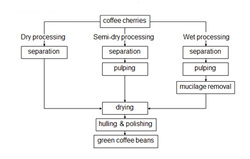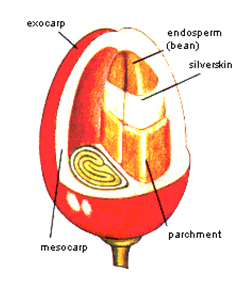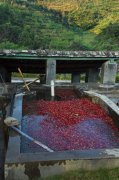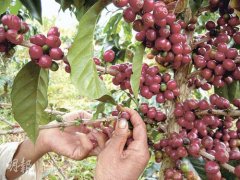A brief introduction to the processing process of High-quality Coffee beans
There are three main methods of processing coffee: drying, semi-drying and non-drying. The purpose of processing is to peel the coffee beans, reduce the moisture content of the coffee beans to a level suitable for preservation, and then process the coffee beans according to market demand. Recently, coffee harvest has been fully spread in Yunnan. I thought it was time to pick out a few of the posts I had posted. I've been planning this for a long time. About a year ago, I posted a blog post called Harvest Rewards. About several ways to harvest coffee in the region. Within 8 hours after picking, coffee cherries should be peeled, otherwise negative fermentation will occur, thus affecting the quality of coffee beans.

There are three main ways to process coffee: drying, semi-drying and non-drying. Yunnan is using the last treatment method. The purpose of the treatment is to peel the coffee beans, reduce the moisture content of the coffee beans to a level suitable for preservation, and then treat the coffee beans according to market demand.

Coffee cherries consist of an exocarp, mucilaginous pulp (mesocarp) and coffee beans (endosperm). As coffee cherries mature, the outer pericarp turns red or yellow. Usually, a coffee berry contains two coffee beans, each surrounded by a brown parchment-like membrane and a white membrane. At each step of the coffee process, a layer of skin is removed from the coffee cherries. In short, the first step of treatment removes the exocarp and pulp; the fermentation process (or machine treatment) removes the mucus from the pulp; the brown film and white film on the outside of the coffee beans are removed during the second drying process. Coffee beans are graded according to size and blemishes, and the final green beans are the ingredients for your daily cup of coffee.
Important Notice :
前街咖啡 FrontStreet Coffee has moved to new addredd:
FrontStreet Coffee Address: 315,Donghua East Road,GuangZhou
Tel:020 38364473
- Prev

Wet treatment methods and steps for processing Yunnan Coffee beans
As the harvest season is almost over, I would like to add an overview of the coffee processing process. In this blog post, I will introduce to you the steps of wet treatment in Yunnan after coffee picking. After harvest, the berries are either sent directly to the pulp collector (if the harvest is done well), or concentrated in a siphon tank filled with water. The berries are here.
- Next

Record of the process of picking coffee beans in Laos
When picking Arabica beans, use your hands to twist them one grain by one. Pick only ripe fruits in bright red, not green (immature) or dark brown (rotten). Generally speaking, coffee trees will bear beans after two or three years of growth and can be picked in four years. Bolaven Cafe comes with clear Americano for breakfast. When picking Arabica beans, use hands to twist them one grain at a time. Choose bright red only
Related
- Beginners will see the "Coffee pull flower" guide!
- What is the difference between ice blog purified milk and ordinary milk coffee?
- Why is the Philippines the largest producer of crops in Liberia?
- For coffee extraction, should the fine powder be retained?
- How does extracted espresso fill pressed powder? How much strength does it take to press the powder?
- How to make jasmine cold extract coffee? Is the jasmine + latte good?
- Will this little toy really make the coffee taste better? How does Lily Drip affect coffee extraction?
- Will the action of slapping the filter cup also affect coffee extraction?
- What's the difference between powder-to-water ratio and powder-to-liquid ratio?
- What is the Ethiopian local species? What does it have to do with Heirloom native species?

